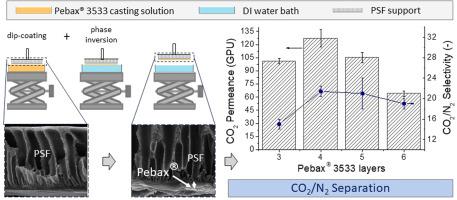Journal of Environmental Chemical Engineering ( IF 7.4 ) Pub Date : 2021-05-09 , DOI: 10.1016/j.jece.2021.105624 Lidia Martínez-Izquierdo , Magdalena Malankowska , Carlos Téllez , Joaquín Coronas

|
Thin film composite membranes of poly(ether-block-amide) copolymer Pebax® 3533 were prepared for the first time on asymmetric polysulfone supports by a phase inversion method. The casting solution concentration and the number of layers were varied to study their influence on the selective layer thickness and the gas separation performance. The casting solution concentrations of polymer dissolved in the 1-propanol/1-butanol mixture were 0.25, 0.5, 1.0 and 1.5 wt.%. These conditions produced membranes with selective skin layers with thicknesses from 0.2 to 1.8 μm. All the membranes were characterized by scanning electron microscopy, thermogravimetric analysis and infrared spectroscopy. Furthermore, the intrinsic viscosity of all the casting solutions was studied to understand the effect of the polymer concentration on the homogeneity and the gas separation properties of the obtained membranes. In general, lower viscosity of casting solutions rendered to more defective skin layers, resulting in a higher number of layers required to obtain selective membranes. The gas separation performance was tested for the post-combustion 15/85 CO2/N2 mixture at 25-50 ⁰C and under a feed pressure of 3 bar. The best separation performance was achieved with the 0.5 wt.% casting solution membranes after the deposition of four polymer layers, obtaining a CO2 permeance of 127 GPU and a CO2/N2 selectivity of 21.4 at 35 ⁰C, the same selectivity of the corresponding dense membrane but with much higher permeance.
中文翻译:

相转化法制备用于CO 2 / N 2分离的Pebax®3533薄膜的方法
通过相转化法首次在不对称聚砜载体上制备了聚(醚-嵌段-酰胺)共聚物3533的薄膜复合膜。改变流延溶液的浓度和层数以研究它们对选择层厚度和气体分离性能的影响。溶解在1-丙醇/ 1-丁醇混合物中的聚合物的流延溶液浓度为0.25、0.5、1.0和1.5 重量%。这些条件产生具有选择的表皮层的膜,其厚度为0.2至1.8 微米 通过扫描电子显微镜,热重分析和红外光谱对所有膜进行表征。此外,研究了所有浇铸溶液的特性粘度,以了解聚合物浓度对所得膜的均匀性和气体分离性能的影响。通常,较低的流延溶液的粘度导致更多的缺陷表皮层,导致获得选择性膜所需的层数更多。在25-50℃和3 bar的进料压力下测试了燃烧后15/85 CO 2 / N 2混合物的气体分离性能 。0.5时达到了最佳分离性能 沉积4个聚合物层后,流延溶液的重量百分比为%,在35℃下获得的CO 2渗透率为127 GPU,CO 2 / N 2的选择性为21.4,与相应的致密膜的选择性相同,但渗透性更高。









































 京公网安备 11010802027423号
京公网安备 11010802027423号